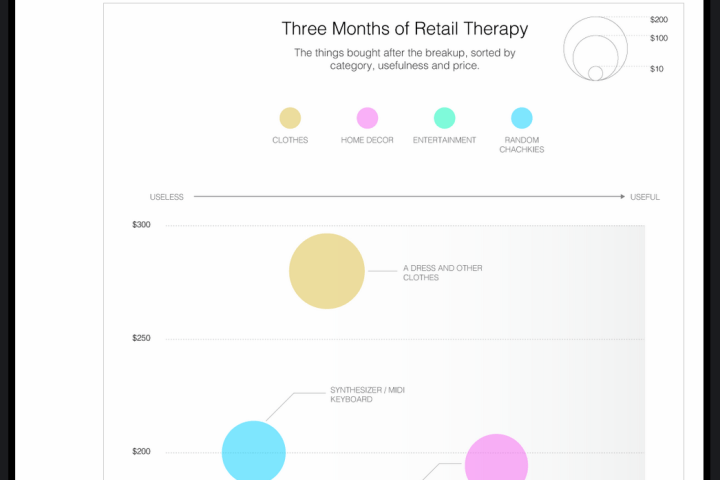
People often act erratically following heartbreak. An underpinning of stability has been removed and we fling ourselves herkyjerk in an attempt to correct, to heal. The period after a breakup is often littered with unwise purchases, excessive alcohol consumption, and borderline-illegal search and texting histories. So the idea of tracking the aftermath of romantic ruin is understandably horrifying — but that didn’t stop interactive editor Lam Thuy Vo from doing just that, creating a blog called Quantified Breakup after her recent relationship dissolution and examining her breakup behavior. Thanks to the Internet and constant connectivity, summing all this data up in its beautiful, depressing glory was rather easy.
Quantified Breakup uses data sets and graphs to organize Vo’s response to her split, and the results are fascinating. A recent post looking at her spending habits divides her purchases according to category, usefulness, and price. Vo took her bank statements and PayPal and Amazon information and formatted them into charts displaying her non-essential purchases, like “stupidly expensive fountain pens” and a variety of home decor. Kind of like Mint for emotional duress.
“I think there’s always this interesting discrepancy between what we think and feel in the moment and how things actually panned out,” Vo tells me, relating this to how she tracked her sleeping patterns.
“For instance, I felt physically exhausted for the first few weeks and thought it was a result of bad sleeping habits. I did have trouble sleeping normally for quite a while but I also slept quite a bit on weekends and, on average, got a lot more sleep than I felt I did.”
She also tracked her movements. She started biking around Chinatown, jogging around Prospect Park, and riding the subway to Coney Island, and made maps tracking her journeys. One somewhat comforting thing for those of us worried about Apple stockpiling our data: Vo found that location data was discarded after seven days. But she was still able to cobble together realistic representations of how she kept her body busy during the breakup.

On her blog, she compares the urge to travel to Forrest Gump’s compulsion to run after Jenny leaves him. “I didn’t quite know where I wanted to go when I left, but kept going til my lazy self felt the need to find refuge in the same apartment I had just fled,” she writes. Too bad she didn’t have a FitBit to graph how many calories her heartsick exercise sessions burned.
There’s a whole movement around the idea of living a quantified life — often called the “quantified self” movement. There’s an idea that we can use access to vast and rapid collections of personal data to our advantage, learning how to optimize our lifestyles through data sets. It’s an idea gaining traction; this school of thought is driving the popularity of fitness accessories (like FitBit) that tally movements and energy expenditures, but it’s being applied all over — and Vo’s Quantified Breakup blog is one example of how someone can use data sets to try to better understand their behavior.
Vo plans at least two or three more blog posts before she retires the experiment, though she has hopes it may turn into a data-based examination of the trials and tribulations of dating and relationships.


